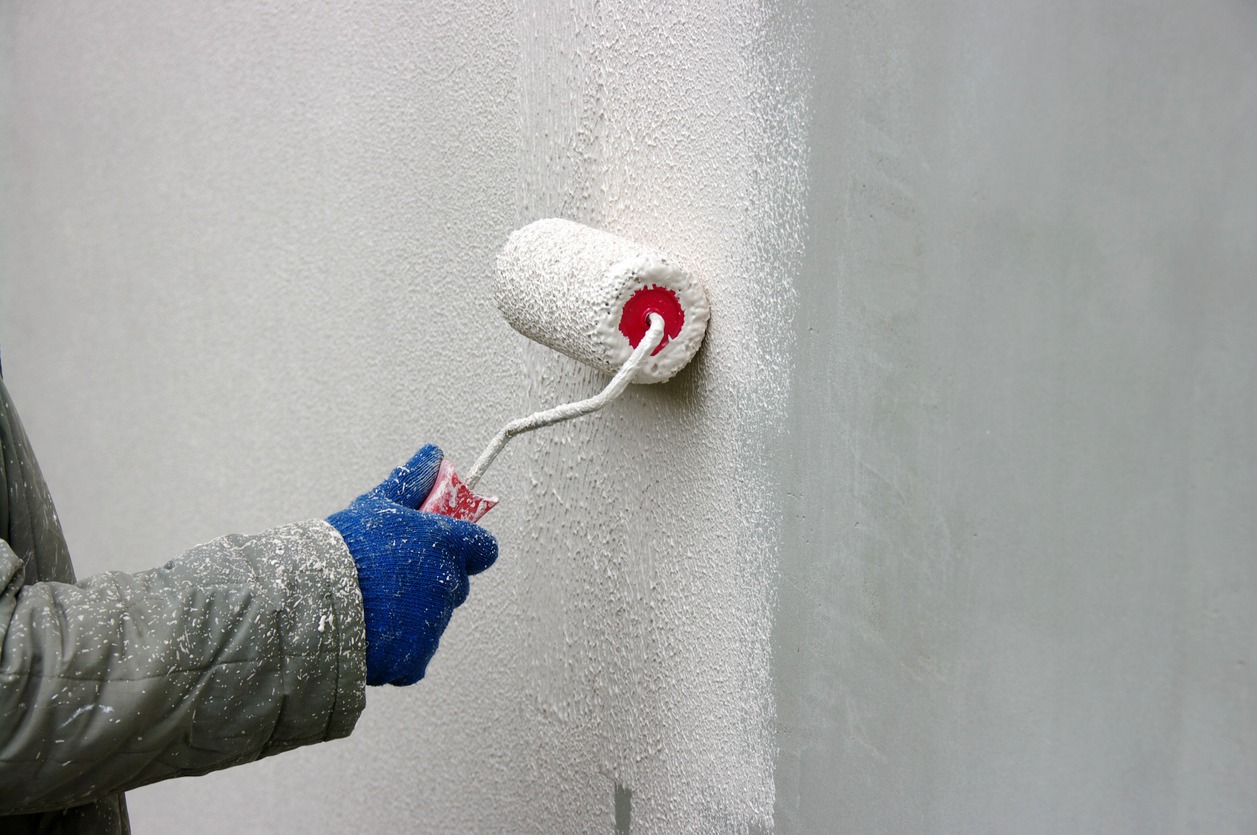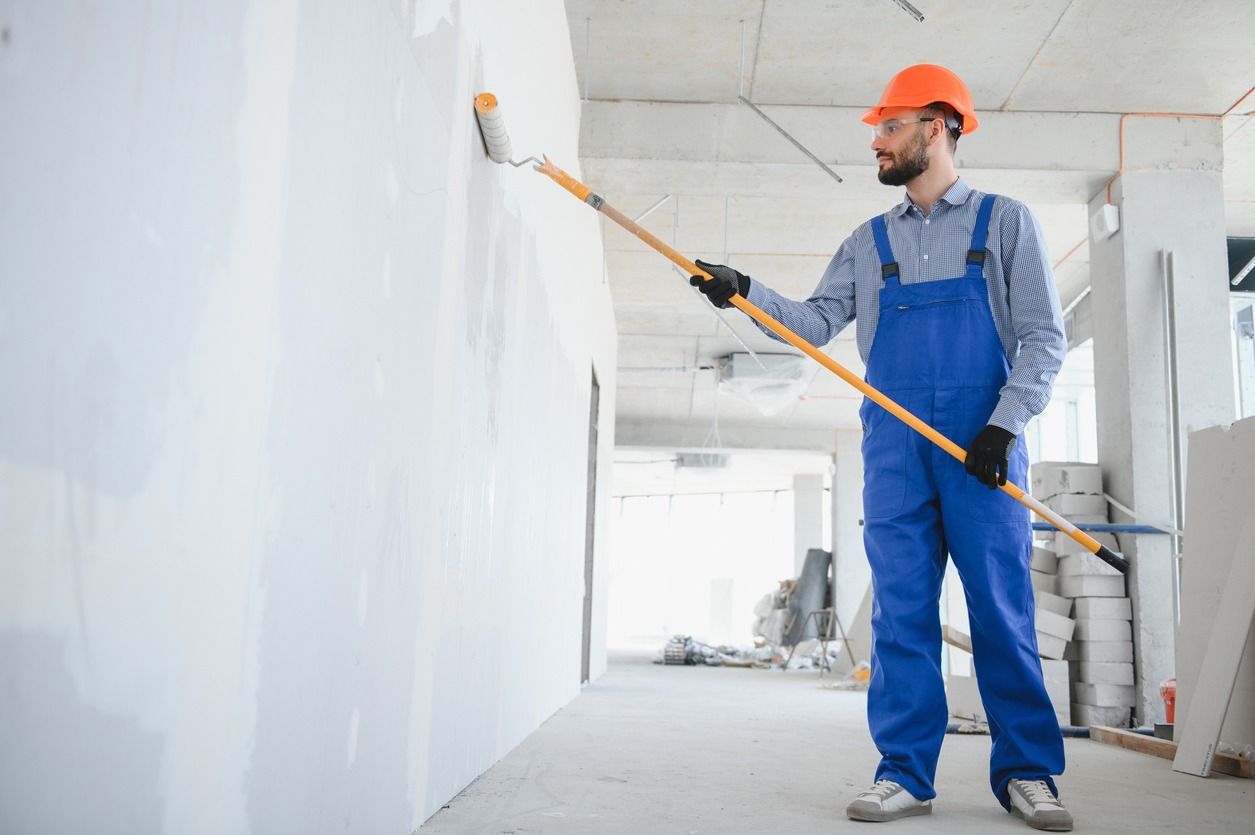When it comes to estimating painting jobs, commercial painters follow a detailed process. They consider factors like the size of the area, the type of surfaces, and the materials needed. In this article, we will look at the steps involved in a typical job estimate so that you can be prepared once you begin a commercial painting project.
What are Commercial Painters?
Commercial painters specialize in painting large-scale properties like office buildings, schools, hospitals, and warehouses. Unlike residential painters, who typically focus on homes and small projects, commercial painters handle more complex and extensive tasks.
These professionals are equipped to work on a variety of surfaces, from walls and ceilings to doors and floors. They have the skills to deal with different materials and finishes, which are often required in commercial spaces.
The scope of work for commercial painters is broader than that of residential painters. They often work in teams to cover large areas efficiently and within tight deadlines. Their work is not just about applying paint; it involves careful preparation of surfaces, which may include cleaning, sanding, and priming. These steps are essential for achieving a durable and professional finish.
Commercial painters also need to be familiar with different types of paints and coatings. Depending on the requirements of the space, they may use specialized products that offer benefits like durability, resistance to wear, or easy maintenance.
The Services That Commercial Painters Offer
Commercial painters offer a wide range of services tailored to meet the needs of businesses and organizations. Their work goes beyond just applying paint, as they also cover various aspects of property maintenance and enhancement. Below are some of the key services provided by commercial painters.
Interior Painting
Interior painting is one of the most common services offered by commercial painters. It involves painting the inside spaces of buildings such as offices, schools, and retail stores. The process usually starts with surface preparation, including cleaning, sanding, and priming, to ensure a smooth application of paint. Commercial painters choose the right type of paint based on the space’s use and the desired finish.
In addition to walls and ceilings, interior painting services may also cover doors, trim, and other interior surfaces. Commercial painters are skilled in working with various materials and finishes, providing a professional look that enhances the overall appearance of the space. They often work around business hours to minimize disruption to operations.
Exterior Painting
Exterior painting is another essential service provided by commercial painters. This involves painting the outside surfaces of buildings, including walls, trim, and sometimes even roofs. The goal is not only to improve the appearance of the property but also to protect it from the elements. Commercial painters use weather-resistant paints and coatings to provide a long-lasting finish.
Preparation is key to successful exterior painting. Painters may need to wash surfaces, remove old paint, and repair any damage before applying new paint. They are also aware of the challenges posed by weather conditions, scheduling their work during optimal conditions to achieve the best results.
Specialized Coatings
Commercial painters often apply specialized coatings that serve specific purposes beyond just aesthetics. These coatings might include anti-graffiti coatings, fire-retardant paints, or waterproofing solutions. Such products are particularly useful in commercial spaces that require extra protection or have specific regulatory requirements.
Applying specialized coatings requires knowledge of the products and the right techniques. Commercial painters are trained to handle these tasks, providing a finish that meets the needs of the space while also complying with any relevant standards. This service is particularly valuable for industries like manufacturing or healthcare.
Surface Preparation
Surface preparation is a crucial part of any painting job, and commercial painters offer this as a standalone service or as part of a larger project. Proper preparation ensures that the paint adheres well and that the final result is smooth and even. This service may involve cleaning, sanding, repairing cracks, and applying primer.
In some cases, surface preparation may require more extensive work, such as removing old layers of paint or dealing with damaged surfaces. Commercial painters are equipped with the tools and knowledge to handle these tasks efficiently, setting the stage for a successful painting job.
Maintenance Painting
Maintenance painting is a service that helps businesses keep their properties looking fresh and well-maintained over time. This involves regular touch-ups and repaints to address wear and tear, ensuring that the property continues to look its best. It’s a proactive approach to property management that can prevent more significant issues down the line.
Commercial painters often work with clients to set up a maintenance schedule that suits their needs. By keeping up with maintenance painting, businesses can extend the life of their paint job and maintain a professional appearance, which is important for attracting customers and creating a positive work environment.
The Parts of a Commercial Painter’s Estimate
When you receive an estimate from a commercial painter, it typically includes several key parts. These parts provide a detailed breakdown of the costs and work involved in the project.
Scope of Work
The scope of work outlines what the painter will do during the project. It details the areas to be painted, the types of surfaces involved, and any specific tasks like surface preparation or minor repairs. This section helps you understand exactly what the painter is committing to and what you can expect once the job is done.
In addition to the tasks, the scope of work may also include information about the materials to be used. This might cover the types of paint, primers, and any additional products required. Knowing the scope of work allows you to compare estimates accurately and avoid any misunderstandings later on.
Labor Costs
Labor costs are a significant part of any painting estimate. This section breaks down the cost of the painter’s time, including the number of workers needed and the estimated hours to complete the job. Labor costs might vary depending on the complexity of the project, the level of detail required, and the painter’s experience.
Understanding labor costs is important because it directly affects your budget. A higher labor cost might indicate a more experienced team or a project that requires more attention to detail. Comparing labor costs across estimates gives you a better idea of the value you are getting for your money.
Materials Costs
Materials costs cover all the supplies needed for the job. This includes paint, primer, brushes, rollers, tape, and any other items necessary to complete the work. The materials cost section will often specify the brands and types of products to be used, which can affect the overall quality and durability of the paint job.
This part of the estimate helps you see where your money is going in terms of supplies. If a painter is using high-quality materials, it might come with a higher price tag, but it could also mean a longer-lasting finish.
Timeline
The timeline section provides an estimate of how long the project will take. This includes start and finish dates, as well as any milestones or deadlines for different phases of the work. A clear timeline helps you plan around the painting project and sets expectations for when the work will be completed.
A well-defined timeline is crucial for minimizing disruptions to your business. Knowing when the painters will be working and when the project will be finished allows you to coordinate with other activities or projects. It also gives you a way to hold the painter accountable for sticking to the agreed schedule.
Additional Costs
Sometimes, an estimate will include additional costs that are not covered in the main sections. These might involve fees for permits, equipment rentals, or other expenses that could arise during the project. This section helps prevent surprises by outlining any potential extra charges.
Understanding additional costs is key to avoiding unexpected expenses. When comparing estimates, it’s important to look at this section to see if all potential costs are accounted for. A detailed estimate with clear additional costs helps you stay within budget and prevents any last-minute financial surprises.
Questions to Ask Commercial Painters for an Estimate
When requesting an estimate from a commercial painter, asking the right questions is essential. These questions help you gather important information about the project and the painter’s approach. Below are some key questions to ask, each aimed at giving you a clearer picture of what to expect.
What Is Included in the Estimate?
Ask the painter to outline all the services covered, such as surface preparation, priming, painting, and clean-up. Knowing what’s included helps you avoid unexpected costs and ensures you are getting a comprehensive service.
This question also allows you to clarify any assumptions or expectations. For example, you might assume that a certain type of paint or finish is included when it’s not. By asking this question, you can ensure that the estimate aligns with your needs and preferences.
How Do You Handle Surface Preparation?
Surface preparation is key to a successful painting job. Ask the painter how they handle this aspect of the project, including any necessary repairs or treatments. A good painter will take the time to properly prepare surfaces, which helps the paint adhere better and last longer.
This question also helps you gauge the painter’s attention to detail and commitment to quality. A painter who skips or shortcuts surface preparation may offer a lower price, but the final result may not meet your expectations.
What Type of Paint Do You Recommend?
The type of paint used can greatly affect the outcome of your project. Ask the painter for their recommendations based on the surfaces and conditions in your space. This might include specific brands or types of paint that offer durability, ease of maintenance, or other benefits.
By asking this question, you gain insight into the painter’s knowledge and experience. A skilled painter will recommend high-quality products that suit your needs and provide a professional finish. This helps you make an informed decision about the materials used in your project.
How Long Will the Project Take?
Knowing the expected timeline for the project is important for planning purposes. Ask the painter how long they anticipate the job will take, from start to finish. This includes any potential delays or factors that might affect the schedule.
This question also allows you to coordinate the painting project with other activities or deadlines. A clear timeline helps minimize disruptions to your business and ensures that the work is completed on time.
What Is Your Experience with Similar Projects?
Experience matters when it comes to commercial painting. Ask the painter about their experience with similar projects, including the types of buildings or surfaces they have worked on. This gives you confidence that they can handle the specific challenges of your job.
This question also provides an opportunity to see examples of their previous work. A painter with experience in similar projects is more likely to deliver results that meet your expectations. By understanding their background, you can choose a painter who is well-suited to your project’s needs.
How Do You Handle Unexpected Issues?
Unexpected issues can arise during any painting project, such as hidden damage or unforeseen complications. Ask the painter how they typically handle these situations. Do they stop working to consult with you first, or do they proceed and address the issue later? Knowing their approach helps you prepare for any surprises and understand how they manage potential problems.
This question also reveals the painter’s communication style and problem-solving abilities. A painter who proactively communicates and offers solutions is more likely to keep the project on track. This can save time and prevent misunderstandings during the job.
Conclusion
Estimating a commercial painting job involves several key steps that ensure accuracy and clarity. From assessing the scope of work to calculating costs and considering timelines, each part of the estimate plays a vital role in planning a successful project.
For professional estimates and painting services, contact our team at Custom Painting, Inc. by calling 925-294-8062 or filling out a Contact Form.



